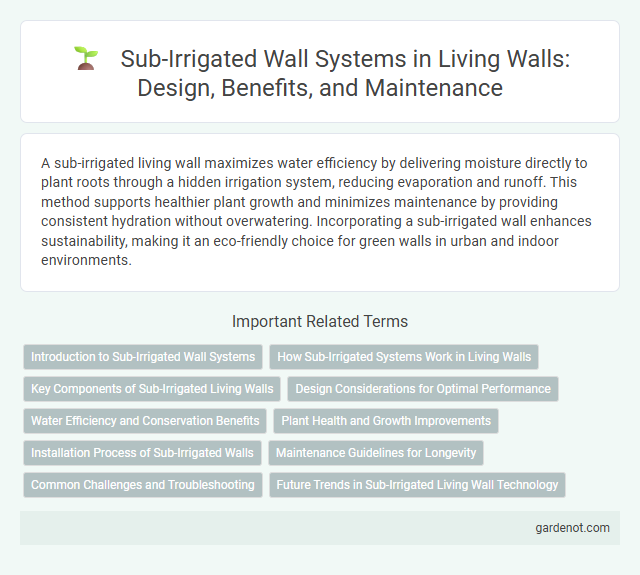A sub-irrigated living wall maximizes water efficiency by delivering moisture directly to plant roots through a hidden irrigation system, reducing evaporation and runoff. This method supports healthier plant growth and minimizes maintenance by providing consistent hydration without overwatering. Incorporating a sub-irrigated wall enhances sustainability, making it an eco-friendly choice for green walls in urban and indoor environments.
Introduction to Sub-Irrigated Wall Systems
Sub-irrigated wall systems utilize a built-in reservoir that supplies water directly to the plant roots, enhancing water efficiency in vertical gardens. These living walls reduce water waste by minimizing evaporation and runoff, promoting healthier plant growth with consistent moisture levels. Ideal for urban environments, sub-irrigated walls combine sustainable irrigation technology with aesthetic green design to improve air quality and indoor ambiance.
How Sub-Irrigated Systems Work in Living Walls
Sub-irrigated living walls utilize a self-watering mechanism where water is stored in a reservoir at the base, allowing plants to absorb moisture through capillary action in the growing medium. This system reduces water waste by delivering water directly to the roots, promoting efficient hydration and healthier plant growth. Integrated wicks or soil layers facilitate continuous water movement, maintaining optimal moisture levels without the need for frequent irrigation.
Key Components of Sub-Irrigated Living Walls
Sub-irrigated living walls incorporate a water reservoir, wicking medium, and a root barrier to ensure efficient moisture delivery directly to plant roots, reducing water waste. The reservoir stores water beneath the soil, while the wicking medium transfers moisture upward through capillary action, promoting healthy root growth. A root barrier prevents roots from penetrating the reservoir, maintaining structural integrity and optimal irrigation.
Design Considerations for Optimal Performance
Sub-irrigated walls require careful design considerations including an efficient water reservoir system to maintain consistent moisture levels and prevent overwatering or root rot. Selecting appropriate plant species with compatible water and light requirements enhances sustainability and aesthetic appeal. Incorporating proper drainage, water flow control mechanisms, and breathable growing media ensures optimal plant health and structural integrity of the living wall.
Water Efficiency and Conservation Benefits
Sub-irrigated living walls drastically enhance water efficiency by delivering moisture directly to plant roots, minimizing evaporation and runoff. This targeted irrigation system conserves water by recycling excess, reducing overall consumption compared to traditional overhead watering methods. Implementing sub-irrigated walls significantly supports sustainable landscaping through optimized water use and reduced resource waste.
Plant Health and Growth Improvements
Sub-irrigated living walls enhance plant health by delivering water directly to the root zone, reducing water loss through evaporation and promoting consistent soil moisture levels. This targeted irrigation method minimizes stress on plants, leading to improved nutrient uptake and robust growth. By maintaining optimal hydration, sub-irrigated walls support healthier foliage and increase the longevity of the plant system.
Installation Process of Sub-Irrigated Walls
The installation process of sub-irrigated living walls involves securely mounting a waterproof panel system designed to retain and distribute water efficiently to plant roots. This system includes integrated water reservoirs and wicking materials that enable constant moisture supply, reducing watering frequency and promoting healthy plant growth. Proper alignment and sealing of the irrigation channels are crucial to prevent leaks and ensure uniform water distribution across the vertical garden.
Maintenance Guidelines for Longevity
Sub-irrigated living walls require regular monitoring of the water reservoir to prevent stagnation and ensure consistent moisture levels for plant roots. Periodic flushing of the irrigation system helps avoid salt buildup and keeps the growing medium healthy. Routine inspection for leaks and cleaning of filters prolongs system efficiency and supports plant vitality.
Common Challenges and Troubleshooting
Sub-irrigated living walls often face challenges such as uneven water distribution leading to root rot or dry spots. Troubleshooting involves ensuring proper capillary action by regularly checking the water reservoir, adjusting wicking materials, and maintaining optimal moisture levels for plant health. Monitoring for clogged irrigation channels and preventing algae buildup enhances system efficiency and plant vitality.
Future Trends in Sub-Irrigated Living Wall Technology
Innovations in sub-irrigated living wall technology emphasize automated water management systems using IoT sensors to optimize hydration and nutrient delivery, reducing water waste by up to 40%. Advanced materials with enhanced capillary action improve water distribution efficiency, supporting a wider range of plant species and increasing wall longevity. Integration of renewable energy sources and AI-driven monitoring will further enhance sustainability and adaptability in urban vertical gardens.
Sub-irrigated wall Infographic

 gardenot.com
gardenot.com